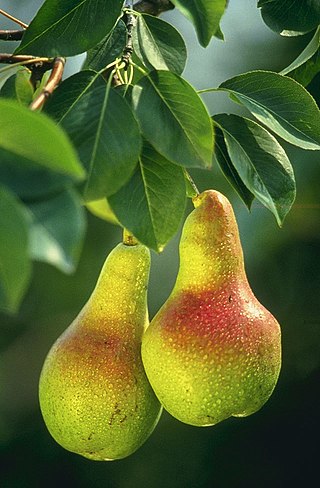
Pears are fruits produced and consumed around the world, growing on a tree and harvested in late summer into mid-autumn. The pear tree and shrub are a species of genus Pyrus, in the family Rosaceae, bearing the pomaceous fruit of the same name. Several species of pears are valued for their edible fruit and juices, while others are cultivated as trees.

Pyrus pyrifolia is a species of pear tree native to southern China and northern Indochina, and have been introduced to Korea, Japan and other parts of the world. The tree's edible fruit is known by many names, including Asian pear, Persian pear, Japanese pear, Chinese pear, Korean pear, Taiwanese pear, apple pear, zodiac pear, three-halves pear, papple, naspati and sand pear. Along with cultivars of P. × bretschneideri and P. ussuriensis, the fruit is also called the nashi pear. Cultivars derived from Pyrus pyrifolia are grown throughout East Asia, and in other countries such as India, Pakistan, Nepal, Australia, New Zealand, and the United States. Traditionally in East Asia the tree's flowers are a popular symbol of early spring, and it is a common sight in gardens and the countryside.

Pyrus × bretschneideri, the ya pear or pearple or Chinese white pear, is an interspecific hybrid species of pear native to North China, where it is widely grown for its edible fruit.
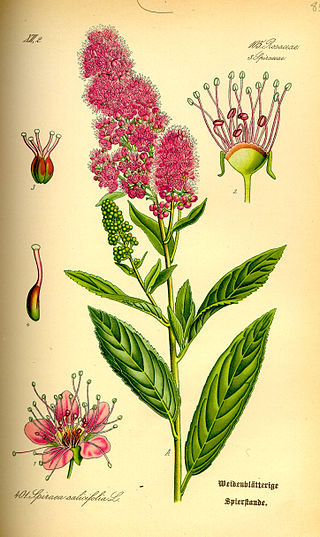
Spiraea, sometimes spelled spirea in common names, and commonly known as meadowsweets or steeplebushes, is a genus of about 80 to 100 species of shrubs in the family Rosaceae. They are native to the temperate Northern Hemisphere, with the greatest diversity in eastern Asia.
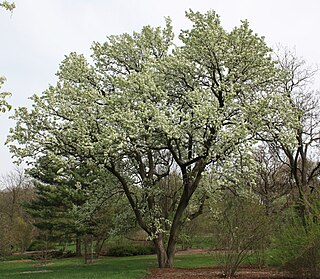
Pyrus calleryana, or the Callery pear, is a species of pear tree native to China and Vietnam, in the family Rosaceae. It is most commonly known for its cultivar 'Bradford' and its offensive odor, widely planted throughout the United States and increasingly regarded as an invasive species.

Pyrus communis, the common pear, is a species of pear native to central and eastern Europe, and western Asia.

Pyrus salicifolia is a species of pear, native to the Middle East. It is widely grown as an ornamental tree, almost always as a pendulous cultivar, and is called by various common names, including willow-leaved pear, weeping pear, and similar. The tree is deciduous and of comparatively small stature, rarely reaching 10–12 meters in height. The crown is rounded. It has pendulous, silvery foliage, superficially similar to a weeping willow. The flowers are large and pure white highlighted with black-tipped stamens although the buds are tipped with red. The small green fruits are inedible, being hard and astringent.

The Williams' bon chrétien pear, commonly called the Williams pear, or the Bartlett pear in the United States and Canada.

Du (Chinese: 杜; pinyin: Dù; Wade–Giles: Tu4) is a Chinese surname. The name is spelled Tu in Taiwan, in Hong Kong it is translated as To, in Macao it is spelled as Tou, the pronunciation of 杜 in Cantonese. The Vietnamese equivalent of the surname is Đỗ. However, when diacritics are dropped, it can also be from the Vietnamese surnames Dư 余 or Dũ 俞 (Chinese equivalent is both Yu). It is the 129th surname in Hundred Family Surnames and is the 42nd most common surname in Mainland China as of 2020.

Psylla pyri, commonly known as the pear psylla or pear psyllid, is an insect in the family Psyllidae. Originating in Europe and Asia, it has spread to North America. It is a pest of pear trees, sucking the sap, damaging the foliage, flowers and fruit and diminishing the crop.

Pyrus pyraster, also called European wild pear, is a species of pear of the family Rosaceae.
Stigmella oxyacanthella is a moth of the family Nepticulidae, found in Europe and North America. The larvae are leaf miners feeding inside the leaves of trees and shrubs, such as hawthorn, apple and pear.

Stigmella pyri is a moth of the family Nepticulidae. It is found from Sweden to the Pyrenees, Italy and Bulgaria, and from Great Britain to Ukraine.
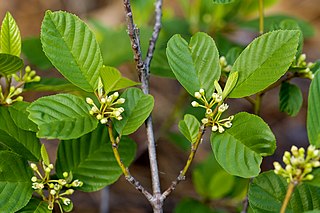
Frangula betulifolia, the birchleaf buckthorn, is a shrub or small tree in the buckthorn family, Rhamnaceae. It is native in northern Mexico in the Sierra Madre Occidental cordillera, and mountainous, desert regions of the Southwestern United States of Arizona, Utah, New Mexico, and far west Texas; besides being found in Sonora, Chihuahua and Durango of the Occidental cordillera, a large species locale occurs to the east in Nuevo León.

Pyrus pashia, the wild Himalayan pear, is a small to medium size deciduous tree of the small and oval shaped crown with ovate, finely toothed leaves, attractive white flowers with red anthers and small pear-like fruits. It is a fruit bearing tree that is native to southern Asia. Locally, it is known by many names such as batangi (Urdu), tangi (Kashmiri), mahal mol (Hindi) and passi (Nepal).

Pyrus bourgaeana, the Iberian pear, is a close relative of Pyrus communis L. The latter was domesticated about 2500 years ago. This small tree is widely distributed across the southern Iberian Peninsula and northern Morocco, where it coexists with four Pyrus species: P. communis L., P. cordata Dew., P. spinosa Forssk, and P. nivalis Jacq. Characteristics to discriminate these species are the width of fruit peduncle, petal size, leaf width and petiole length served to the taxa.

Pyrus cordata, the Heart-leaved pear or Plymouth pear, is a rare wild species of pear belonging to the family Rosaceae. It gets its name in Spanish, Portuguese and French from the shape of its leaves. In the UK, it is known as Plymouth Pear after the city of Plymouth in Devon, where it was originally found in 1870 The Plymouth pear was one of the British trees to be funded under English Natures Species Recovery Programme.
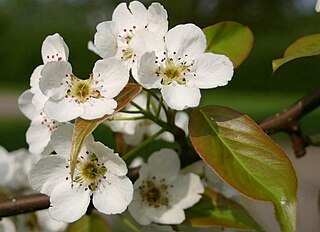
Pyrus ussuriensis, also known as the Ussurian pear, Harbin pear, and Manchurian pear, is a species of flowering plant in the family Rosaceae.
Pyrus phaeocarpa, the dusky pear or orange pear, is a species of flowering plant in the family Rosaceae, native to the Loess Plateau of northern China. A wide tree reaching at most 7–8 m (23–26 ft) in height, it is hardy to USDA zone 5, or perhaps even zone 4. Its small yellow to brown fruit are edible, and its Autumn foliage is bright orange to orange-red, giving it good potential as an ornamental. Its chloroplast genome shows that it is closely related to Pyrus pashia, the wild Himalayan pear, and it is suspected to be a hybrid of P. betulifolia, the birchleaf pear, P. pyrifolia, the apple pear, and P. ussuriensis, the Manchurian pear.
Pyrus regelii is a species of wild pear in the family Rosaceae, native to Central Asia. A small tree usually 6 m (20 ft) tall, but reaching 9 m (30 ft), its young branches are cloaked in a grey down, which provides visual interest when it is planted as an ornamental. Its leaves, which are also downy when young, are exceptionally variable in shape, sometimes even on the same individual. The fruit are small but typical pears, and are collected and eaten by local peoples. The most xerophytic member of its genus, it is occasionally used as a rootstock for cultivated pear trees, as a garden ornamental, and for reforestation projects, all in dry areas.















